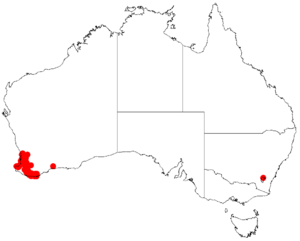Acacia incurva facts for kids
Quick facts for kids Acacia incurva |
|
|---|---|
| Scientific classification | |
| Genus: |
Acacia
|
| Species: |
incurva
|
 |
|
| Occurrence data from AVH | |
Acacia incurva is a type of plant that grows as a shrub. It belongs to a large group of plants known as Acacia. This special plant is found naturally only in the South West part of Western Australia.
Contents
About Acacia incurva
What Does It Look Like?
Acacia incurva is a small shrub. It can grow low to the ground or stand upright. It often has many stems. This plant also has small, sharp points, like tiny spines. It usually grows to be about 0.2 to 0.5 meters (0.6 to 1.6 feet) tall.
Its stems are not perfectly round; they have angles. Instead of regular leaves, it has special parts called phyllodes. These phyllodes are like flattened stems that do the job of leaves. They are long and narrow, like a line or a small spearhead. They can be from 10 to 50 millimeters (0.4 to 2 inches) long and 1 to 2 millimeters (0.04 to 0.08 inches) wide.
Its Flowers and Seeds
This plant blooms during the winter, usually from July to September. It produces bright yellow flowers that are shaped like small balls. Each flower cluster is round and has about six to eleven tiny, bright yellow flowers.
After the flowers, Acacia incurva forms seed pods. These pods are long and round, like a tube. They can grow up to 7 centimeters (2.8 inches) long and are about 2 millimeters (0.08 inches) wide. The pods are tough and reddish, with lines running along them.
Where Does It Grow?
Acacia incurva likes to grow in wet places. You can find it in swamps or areas that get very wet during winter. It also grows on flat areas made of clay. This shrub can live in different types of soil, including sandy, clay, or lateritic soils. Lateritic soil is a type of red soil often found in warm, wet regions.
How Was It Discovered?
The first official description of Acacia incurva was made by a botanist named George Bentham. He described it in 1842. This description was part of a larger book called Notes on Mimoseae, with a synopsis of species, written by William Jackson Hooker. Over time, this plant has had a few different names, but Acacia incurva is its main accepted name today.

